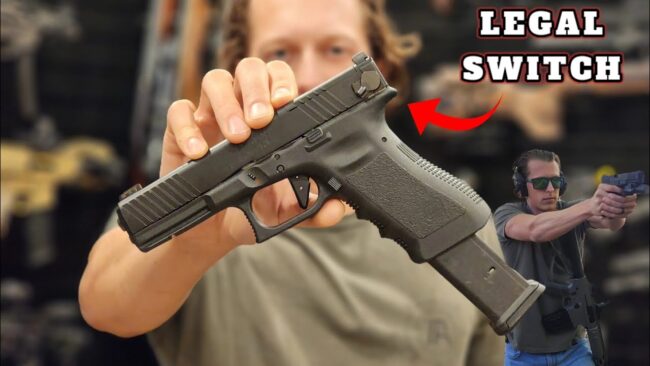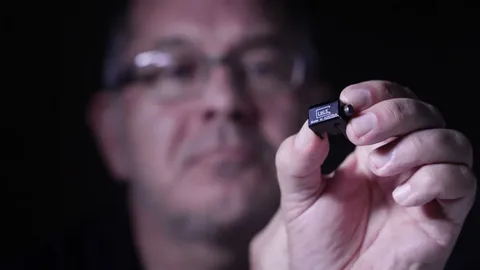The Glock pistol is among the most popular handguns globally, prized for its durability, simplicity, and reliability. However, an accessory known as
The Glock pistol is among the most popular handguns globally, prized for its durability, simplicity, and reliability. However, an accessory known as the Glock switch has recently gained notoriety, raising concerns among law enforcement, policymakers, and the public.
This device can transform a semi-automatic Glock into a fully automatic firearm — a conversion that carries serious legal ramifications and safety risks. In this article, we’ll explore the Glock switch’s design, how it functions, its legality, and the broader effects on firearm ownership and regulation.
What Is a Glock Switch?
A Glock switch is a small mechanical device that converts a semi-automatic Glock pistol into a fully automatic weapon. Usually compact — fitting easily in the palm of a hand — it replaces or modifies internal components related to the trigger mechanism.
By enabling the firearm to fire multiple rounds continuously with a single trigger pull, the Glock switch significantly increases the gun’s rate of fire. This changes the classification of the pistol from semi-automatic to fully automatic under most firearm laws.
How Does the Glock Switch Work?
To understand the switch’s effect, it helps to know how a Glock pistol normally functions:
- Semi-Automatic Operation: Pulling the trigger releases the striker, firing one round. The slide cycles, ejecting the spent casing and chambering a new round. The trigger resets, requiring another pull for each shot.
- Conversion via the Switch: The Glock switch interrupts the trigger’s normal reset process by modifying or bypassing the trigger bar or sear. As a result, the trigger remains engaged, allowing the striker to fire repeatedly while the trigger is held down.
The device’s small size and simple mechanical design mean it can often be installed or removed without permanent changes to the firearm, making it easily concealable and highly portable.
Legal Status of Glock Switches
United States Federal Law
The Bureau of Alcohol, Tobacco, Firearms and Explosives (ATF) classifies any device that enables a semi-automatic firearm to fire automatically as a machine gun under the National Firearms Act (NFA). Glock switches fall squarely into this category.
- Illegal Possession: Owning or manufacturing a Glock switch without proper NFA registration is a felony.
- Penalties: Violations can result in hefty fines, imprisonment for up to 10 years or more, and seizure of firearms.
- Sale and Transfer: Selling or transferring these devices without authorization is also illegal.
State and Local Regulations
Many states enforce their own laws regulating machine guns and conversion devices, sometimes imposing stricter penalties than federal law. Certain localities outright ban possession of such devices regardless of federal registration.
International Context
Globally, countries with strict gun laws generally ban devices like Glock switches. International agreements and local statutes classify them as illegal firearm accessories due to the increased danger they pose.
Why Are Glock Switches a Concern?
Public Safety
The ability to fire continuously dramatically increases a handgun’s lethality. This is particularly dangerous in urban environments and public spaces, where rapid, uncontrolled gunfire can cause mass casualties.
Criminal Use
Glock switches have been found in the hands of criminals seeking to enhance the firepower of readily available semi-automatic pistols. Their small size makes them easy to conceal, transport, and use with little warning.
Law Enforcement Challenges
Because the device is small and can be attached or removed quickly, law enforcement faces challenges in detection and prevention. Traditional firearm regulations and screenings may not account for such easily concealed conversion devices.
Technical and Safety Risks
- Mechanical Failures: Poorly made or incorrectly installed Glock switches can cause malfunctions, jams, or catastrophic failures, potentially injuring the user.
- Loss of Control: Fully automatic fire from a handgun is difficult to control, increasing the risk of unintended harm.
- Legal Liability: Beyond personal risk, owners may face severe criminal charges and lifelong legal consequences.

The Debate Around Glock Switches
Gun Rights Perspective
Advocates emphasize the importance of responsible ownership and adherence to laws. They argue for better education and focus on criminal misuse rather than banning accessories outright, highlighting the importance of Second Amendment rights.
Gun Control Perspective
Proponents call for stricter regulations and enforcement to prevent dangerous modifications that increase firearm lethality, citing Glock switches as a clear example of a public safety threat that requires urgent attention.
Law Enforcement and Policy
Policymakers and police agencies seek balanced approaches, aiming to protect constitutional rights while mitigating risks posed by these conversion devices through education, legislation, and enforcement.
What Should Gun Owners Know?
- Avoid Illegal Modifications: Possession or use of a Glock switch without registration is illegal.
- Understand the Risks: Beyond legality, conversion devices increase the chance of accidents and injuries.
- Stay Informed: Laws and regulations can change; keeping up to date is crucial for responsible ownership.
- Report Suspicious Devices: If you come across a Glock switch or similar device, notify law enforcement immediately.
Legal Alternatives for Enthusiasts
- NFA-Compliant Machine Guns: Fully automatic firearms may be legally owned if registered with the ATF and accompanied by tax stamps.
- Semi-Automatic Firearms: Many pistols offer high-capacity magazines and rapid semi-automatic firing without conversion.
- Simulated Automatic Fire: Some firearms are designed to simulate burst fire within legal parameters.
Conclusion
The Glock switch may be a small mechanical device, but its impact on firearm safety, legality, and public policy is substantial. It highlights the ongoing challenges of balancing technological advances in firearms with public safety and legal frameworks.
For firearm owners, understanding the laws and risks associated with such devices is essential. For communities and policymakers, the Glock switch represents a clear call to carefully consider regulation, enforcement, and education to reduce potential harms.
Frequently Asked Questions (FAQs)
Q1: What exactly is a Glock switch?
A Glock switch is a device that converts a semi-automatic Glock pistol into a fully automatic weapon by altering the trigger mechanism.
Q2: Are Glock switches legal to own or sell?
No. In the U.S. and many other countries, owning, selling, or manufacturing Glock switches without proper federal registration is illegal.
Q3: What are the dangers of using a Glock switch?
They significantly increase the rate of fire, making the firearm harder to control and increasing risks of accidents and criminal misuse.
Q4: Can law enforcement easily detect Glock switches?
Detection is challenging due to their small size and portability, but police use intelligence and inspections to identify illegal devices.
Q5: Are there legal ways to own fully automatic firearms?
Yes. Fully automatic firearms can be legally owned if registered under the National Firearms Act with the appropriate licenses and tax payments.
Q6: What penalties do offenders face for illegal Glock switch possession?
Penalties include severe fines, federal prison sentences, and confiscation of firearms.
Q7: Can a Glock switch damage the firearm?
Improper installation or use of a Glock switch can cause mechanical issues or damage the pistol.
Q8: What should someone do if they find a Glock switch?
They should report it to local law enforcement or the ATF immediately, as possession without registration is a federal crime.
Must Visit: onlinemrkting




COMMENTS